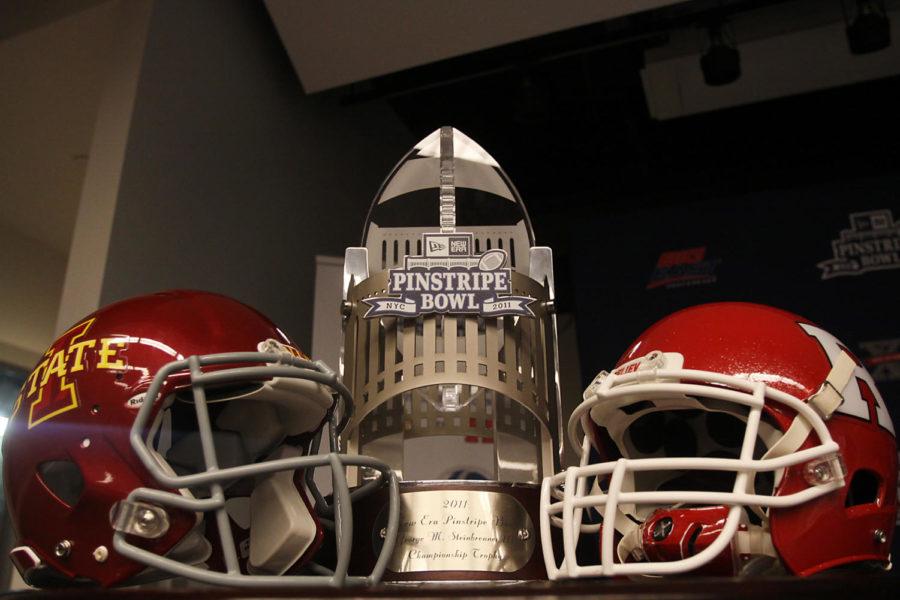Records show school’s bowl expenditures
Photo: Jordan Maurice/ Iowa State Daily
Iowa State and Rutgers square off in the second annual Pinstripe Bowl at Yankee Stadium on Friday, Dec. 30. The two teams meet Friday after a week of enjoying New York.
April 2, 2012
Iowa State turned a $53,523 profit from its football team’s trip to the 2011 Pinstripe Bowl, according to school and conference records obtained by the Daily via Freedom Of Information Act requests.
The trip to the bowl game — Iowa State’s second in three years under the tutelage of coach Paul Rhoads — cost the school $1,286,477, which is well under the $1.34 million allocated by the Big 12 Conference.
“Generally when you go on a bowl trip, you try to make it a zero-sum game,” said Steve Malchow, ISU senior associate athletic director. “Generally, the allotments that are set are good-faith guesstimates as to what it costs to travel a football team to that particular city because there’s certainly going to be a lot of differences depending on how far you’re traveling.”
However, the school’s surplus from the Pinstripe Bowl — which it lost 27-13 to Rutgers — was not as much as it saved from its Insight Bowl appearance in 2009. For that trip to Tempe, Ariz., Iowa State logged a net income of $158,850, according to school records submitted to the NCAA.
“Bowl opportunities are great institutional events,” said ISU Athletic Director Jamie Pollard in February, before the Pinstripe Bowl expense report was released. “It’s a wonderful opportunity for our student-athletes to give them a reward, a chance to play another football game.”
Pollard was unavailable for comment after the Pinstripe Bowl records were released.
The Big 12 gathers all of the money the schools make from the bowls and puts it into “one big pot,” Pollard said, with a pre-determined formula used to decide how much money will be allocated to a school for playing in a particular bowl.
With the formula applied, Iowa State received $1 million from the Big 12 to play in the Pinstripe Bowl, as well as $300 per one-way travel mile, said Bob Burda, associate commissioner for Big 12 communications.
“Each of the schools that participate gets that amount of money to help go toward defraying their expenses,” Pollard said. “The residual that’s left over at the conference level, they take all those payouts, less the pre-determined formula, that difference is divided equally amongst all members whether you went to a bowl game or not.”
Malchow said planning for a bowl trip is a meticulous process that requires a mapping out of every single excursion along with the minor details such as planning where to practice or where to stay, among others.
“All the bowls have different things you’re required to attend, so you’ve got to fit those into your weekly planning,” Malchow said. “You’ve got to work that around the practice schedule that coach Rhoads wants to have.
“The amount of logistics, it’s hard to quantify. But there are countless meetings.”
Those countless meetings have translated into two carefully planned bowl trips for Iowa State, as it has brought in surpluses for its most recent trips.
“Each school that participates gets their allowance and then the goal of the school is to spend that accordingly,” Pollard said. “In our particular case when we went to Phoenix, we were able to stay underneath that number, which gave us a surplus for that particular event.”
A portion — $125,000 — of the $158,850 surplus from the 2009 bowl trip was used to pay for half the cost of new uniforms for the ISU varsity marching band, which were debuted at the beginning of the 2011 season.
“Because we didn’t all fit on one plane, Jamie gave us the option of, ‘Well, we can bus you and we would, therefore, save a lot of money and we’ll use some of that extra money that we save and apply it to the uniform account,’” said former ISU Band Director Matt Smith.
“At the time, we were still in our old uniforms and we were investigating new uniforms and how we could afford those, so he made that proposal, which worked beautifully.”
Smith, who is now the band director at the University of Kansas after serving that position at Iowa State from 2002 until 2010, said the choice was a “slam dunk” when it came between taking a portion of the band and traveling by plane or taking the entire band and traveling by bus.
As for the surplus from the Pinstripe Bowl, Malchow said there was a much simpler plan for it.
“Our pooled revenues support our pooled expenses,” Malchow said. “Essentially, over the course of the year, we make revenues in a lot of different fashions and we have a lot of bills to pay and you don’t tie them task to task.
“You pool all your revenues and that’s the money you have available to spend.”







